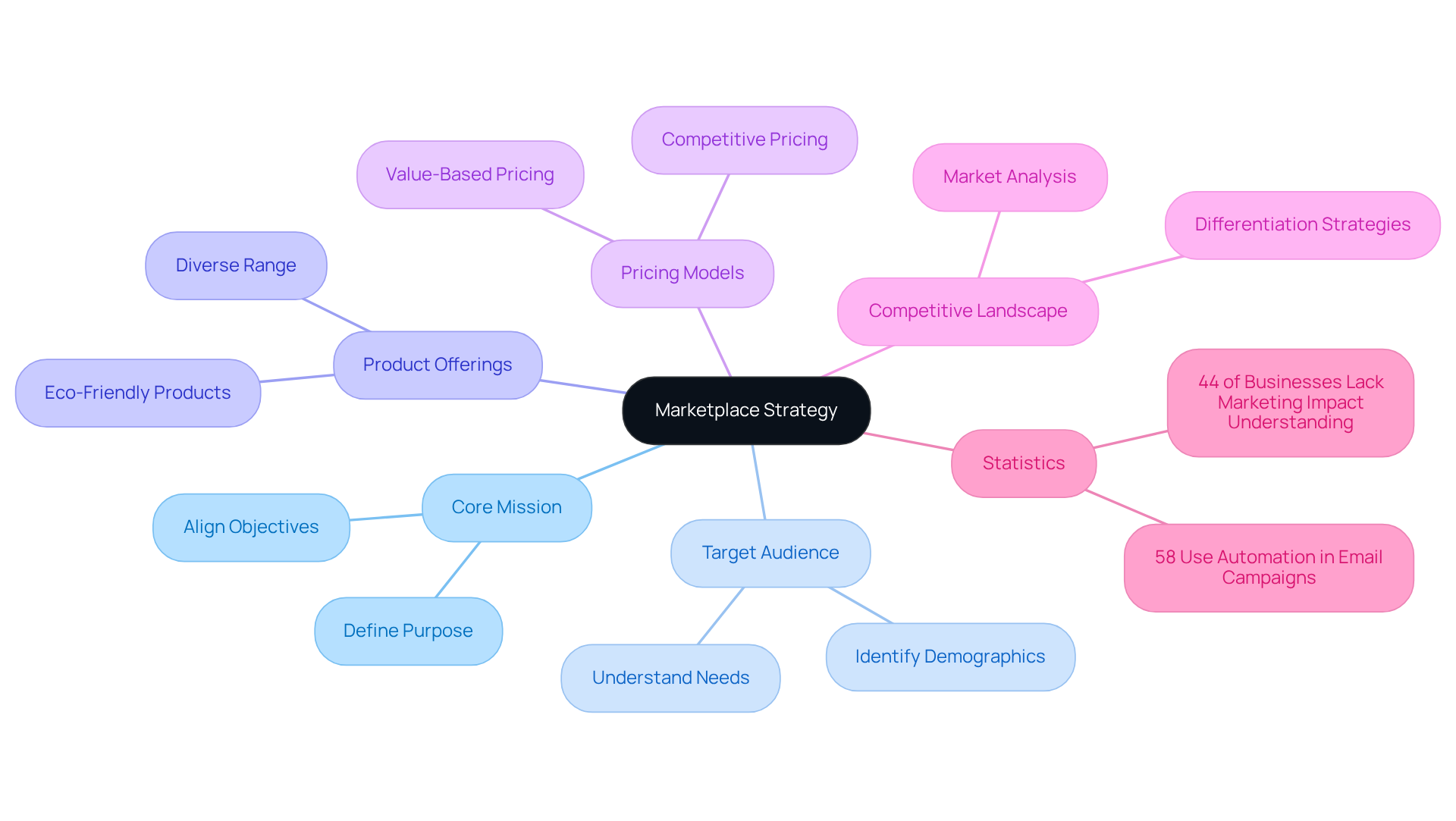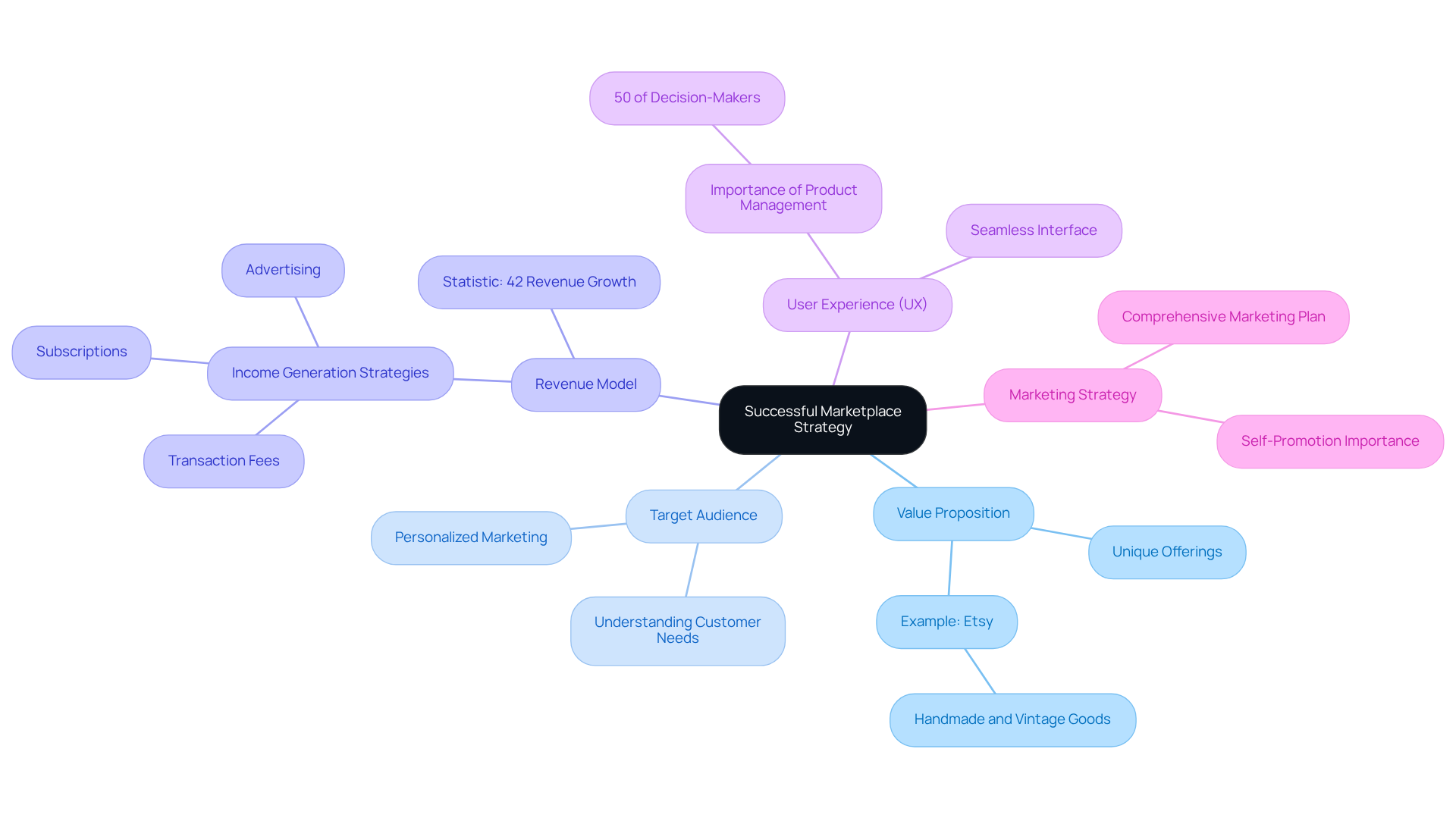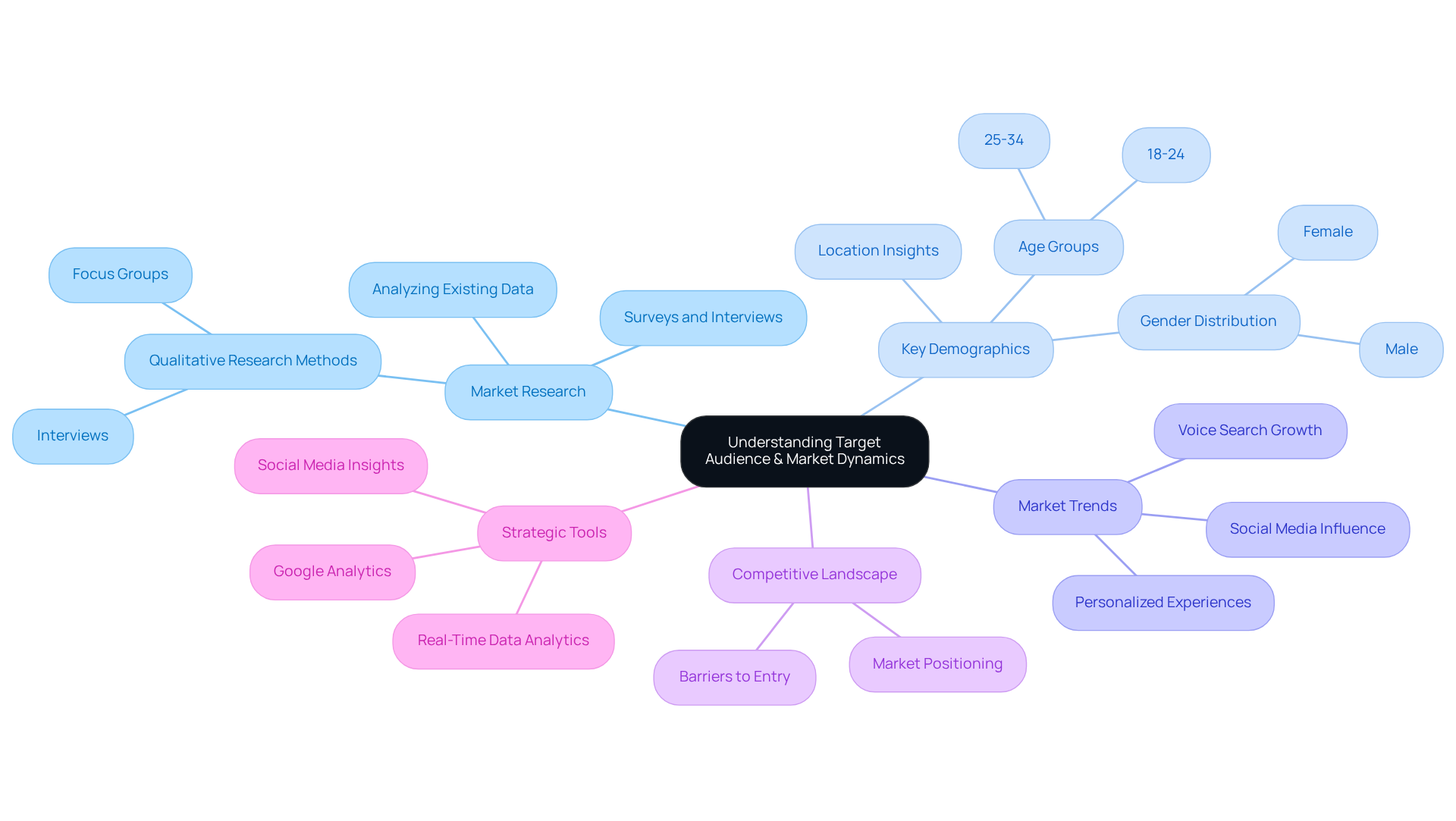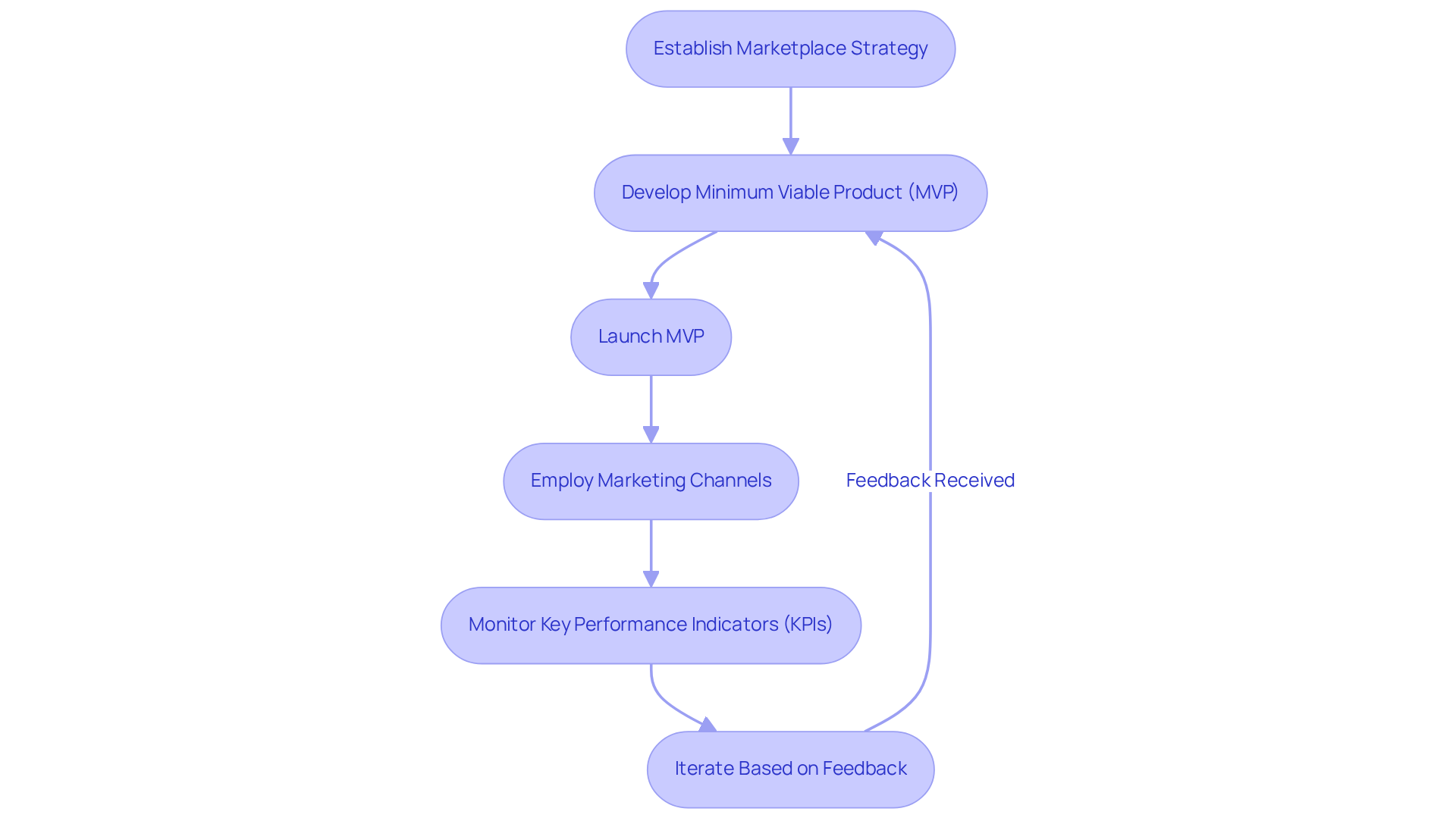Overview
Navigating the marketplace can be a daunting challenge for startups. Many founders find themselves overwhelmed, unsure of how to define their mission or connect with their target audience. This uncertainty can lead to frustration and feelings of isolation, as the pressure to succeed mounts. However, there is hope. By mastering a marketplace strategy, startups can not only survive but thrive.
Start by clearly defining your mission—what drives you? Understanding your target audience is equally crucial; it allows you to tailor your approach and truly resonate with potential customers. Implementing effective marketing and operational practices can make a significant difference. A clear value proposition and a revenue model that aligns with your audience’s needs are essential components of this journey.
Continuous monitoring of performance metrics is vital as well. It enables you to adapt and refine your strategies in response to the ever-changing market dynamics. This proactive approach fosters long-term growth and strengthens customer engagement. Remember, you are not alone in this journey, and with the right support and strategies, success is within reach.
Introduction
Crafting a successful marketplace strategy is not just important; it's essential for startups striving to thrive in today's competitive landscape. Many entrepreneurs find themselves grappling with the challenge of quantifying their marketing impact, with nearly half of businesses struggling to find clarity and direction. This uncertainty can feel overwhelming, but it’s important to know that you are not alone in this journey.
In this article, we will explore the foundational elements of an effective marketplace strategy, offering insights designed to empower you to:
- Define your unique value propositions
- Understand your target audience
- Implement strategies that foster engagement and growth
What challenges do you face in navigating this complex terrain? Together, we can discover ways to overcome these obstacles and achieve lasting success.
Define Your Marketplace Strategy
To define your business strategy, begin by reflecting on your core mission and objectives. Consider the challenge your platform seeks to address and identify your target audience. This clarity will illuminate your decisions regarding product offerings, pricing models, and your overall marketplace strategy. Additionally, it's essential to be mindful of the competitive landscape and explore how your platform can distinguish itself. Utilizing frameworks like the can help visualize your approach and ensure all components harmonize with your overarching goals. For instance, if your platform focuses on eco-friendly products, your strategy should emphasize sustainability in every aspect, from sourcing to promotion.
Current statistics reveal a pressing issue in the market:
- 44% of businesses struggle with a quantitative understanding of their marketing impact
- 58% of marketing decision-makers leverage automation in email campaigns
This highlights the urgent need for a marketplace strategy that emphasizes strategic clarity and efficiency. Successful tech startups, particularly those embracing innovative digital experiences, exemplify how a targeted approach can significantly enhance engagement and sales. By prioritizing your core mission, you can cultivate a compelling value proposition that resonates deeply with consumers, fostering long-term growth and connection.

Key Components of a Successful Marketplace Strategy
For many startup founders, creating a successful marketplace strategy can often feel overwhelming. The pressure to stand out in a crowded market can lead to feelings of uncertainty and doubt. This is where a clear and compassionate approach becomes essential.
- Value Proposition: It’s crucial to articulate what makes your platform unique and why users should choose it over competitors. A compelling value proposition not only attracts customers but also fosters loyalty. Take Etsy, for example; it thrives by highlighting its distinctive offering of handmade and vintage goods, which resonates deeply with its dedicated community of buyers.
- Target Audience: Understanding your ideal customers is vital. By delving into their needs and preferences, you can tailor your marketing efforts and product offerings to meet their expectations. This personalized approach can .
- Revenue Model: It’s important to have a clear plan for generating income—be it through transaction fees, subscriptions, or advertising. A well-defined revenue model is not just a strategy; it’s the backbone of sustainability and growth. In fact, companies that have launched platforms have seen an impressive average revenue growth of 42% year-over-year, underscoring the importance of a solid strategy.
- User Experience (UX): Prioritizing a seamless and engaging user experience is essential. A user-friendly interface and intuitive navigation can significantly boost customer satisfaction and encourage repeat visits. After launching, many decision-makers, about 50%, realized that managing product information and sales data was more crucial than they had anticipated, highlighting the need for ongoing optimization.
- Marketing Strategy: Developing a comprehensive marketing plan is key. This should include digital marketing, social media engagement, and strategic partnerships to drive traffic and attract customers. Effective self-promotion and targeted outreach are vital in distinguishing yourself in a competitive landscape. As Jay Abraham wisely notes, knowing how to present yourself and your ideas is fundamental to achieving success.
By focusing on these essential elements and remaining aware of common pitfalls, startups can cultivate a robust marketplace strategy that attracts participants while fostering lasting engagement and growth. The positive feedback from clients praising RNO1's design-first mindset and impactful results serves as a testament to the effectiveness of these strategies. Remember, you’re not alone in this journey; together, we can navigate the challenges and celebrate the successes.

Understand Your Target Audience and Market Dynamics
Understanding your can feel overwhelming, but it’s a crucial step for your success. Many startup founders struggle with this aspect, often feeling lost in the sea of data and demographics. By conducting market research—through surveys, interviews, and analyzing existing data—you can formulate a marketplace strategy to navigate these waters. It's important to identify key demographics, such as age, gender, location, and purchasing behavior, as these insights can illuminate your path forward.
As you delve deeper, consider the marketplace strategy along with the market trends and dynamics that shape your industry. Recognizing the competitive landscape and potential barriers to entry can strengthen your marketplace strategy, helping you feel more prepared and confident. Tools like Google Analytics and social media insights can be your allies, providing valuable data on user behavior and preferences. For instance, if your platform aims to engage millennials, prioritizing mobile optimization and social media promotion is essential, as these channels resonate deeply with this demographic.
By comprehending these dynamics, you can customize your offerings and marketplace strategy to meet the specific needs of your audience. Remember, you’re not alone in this journey; many founders have faced similar challenges and found success by embracing these insights. Together, we can cultivate a deeper understanding of your audience, paving the way for a more impactful connection with them.

Implement and Monitor Your Marketplace Strategy
With your marketplace strategy established, the next step is to develop a Minimum Viable Product (MVP) that includes the essential features required to attract those initial participants. This approach enables startups to test their ideas swiftly and gather invaluable feedback, significantly mitigating the risk of failure. As Eric Ries wisely states, "An MVP is not the smallest product you can build, but it is the fastest way to start learning." Once your MVP is launched, consider employing various marketing channels—like social media, email campaigns, and strategic partnerships—to drive traffic and foster engagement.
After launching, it's crucial to consistently monitor key performance indicators (KPIs) such as client acquisition rates, transaction volumes, and customer feedback. Utilizing tools like Google Analytics and customer relationship management (CRM) systems can empower you to track performance effectively and gather actionable insights. For instance, if the data reveals a notable drop-off rate during the checkout process, it may indicate a need to enhance the experience for visitors, thereby reducing friction and improving conversion rates.
Startups that embrace the MVP approach can reach the market approximately 35% faster than those relying on traditional methods. This speed allows for and visibility—both critical components for long-term growth. Furthermore, statistics show that around 72% of startups utilizing an MVP approach refine their products based on client feedback, which can reduce development expenses by up to 60%. Additionally, startups employing MVPs tend to implement 30% more product changes than those using conventional methods, underscoring the iterative nature of this approach. This iterative process not only boosts cost efficiency but also ensures that resources are allocated to features that genuinely meet user needs, ultimately enhancing the likelihood of achieving product-market fit. Notably, startups that test pricing assumptions and value propositions through MVPs are about 50% more likely to establish sustainable revenue models. A compelling example of this is Airbnb's initial MVP launch, where the founders created a simple website to rent out air mattresses, illustrating the power of rapid learning and adaptation in entrepreneurship.

Conclusion
Mastering a marketplace strategy can feel daunting for startups striving to find their place in a competitive landscape. It’s essential to clearly define your core mission and understand the dynamics around you. This journey is not just about addressing market needs; it’s about connecting with your audience on a deeper level. By emphasizing unique value propositions, personalized user experiences, and robust revenue models, you can lay the foundation for a successful marketplace approach.
Key insights remind us of the importance of understanding customer demographics and leveraging effective marketing strategies. Implementing a Minimum Viable Product (MVP) allows you to gather invaluable feedback. Focusing on these fundamental components can help you navigate the complexities of the marketplace, enhancing your chances of success. Remember, continuous monitoring and adapting your strategies based on performance metrics are vital to staying agile and responsive to the ever-changing market dynamics.
Ultimately, mastering a marketplace strategy transcends immediate gains; it’s about nurturing long-term relationships and fostering loyalty among your customers. Embrace these best practices, engage deeply with your audience, and commit to refining your approach. By doing so, you position yourself not only for success in your initial endeavors but also for sustained growth in the evolving marketplace landscape. You are not alone in this journey—many founders share similar experiences, and together, we can create a supportive community that thrives.
Frequently Asked Questions
How can I define my marketplace strategy?
To define your marketplace strategy, reflect on your core mission and objectives, identify the challenge your platform addresses, and determine your target audience. This clarity will guide your decisions on product offerings, pricing models, and overall strategy.
Why is it important to understand the competitive landscape?
Understanding the competitive landscape is essential as it helps you explore how your platform can distinguish itself from others, ensuring that your strategy is relevant and effective in the market.
What tools can help visualize my marketplace strategy?
Frameworks like the Business Model Canvas can help visualize your marketplace strategy and ensure that all components align with your overarching goals.
How should my strategy reflect my platform's focus, such as eco-friendliness?
If your platform focuses on eco-friendly products, your strategy should emphasize sustainability in all aspects, including sourcing and promotion, to ensure a cohesive approach.
What current statistics highlight the need for a strong marketplace strategy?
Current statistics show that 44% of businesses struggle with understanding their marketing impact quantitatively, and 58% of marketing decision-makers use automation in email campaigns, indicating a need for strategic clarity and efficiency.
How can a targeted marketplace strategy benefit my business?
A targeted marketplace strategy can significantly enhance engagement and sales, as seen in successful tech startups that embrace innovative digital experiences. Prioritizing your core mission helps cultivate a compelling value proposition that resonates with consumers.




